The Bank of Japan recently engaged in a debate regarding the potential for a near-term interest rate hike, as revealed by a meeting summary. The discussion centered around addressing the risks associated with inflation surpassing expectations. One member of the board advocated for an immediate increase in interest rates to tackle this issue without delay. This suggests a growing awareness within the BOJ of the mounting inflationary pressure in the world’s third-largest economy. The upcoming policy meeting on July 30-31 could potentially see deliberations on raising interest rates based on the current economic climate.
Impact of Declining Yen on Policy Rate
The recent depreciation of the yen has raised the likelihood of an upward adjustment to the BOJ’s inflation forecasts. This, in turn, could necessitate a reevaluation of the appropriate level of the policy rate. Discussions during the June 13-14 meeting highlighted the need for vigilant monitoring of data leading up to the next policy meeting in July. The members acknowledged the increased visibility of upside risks to prices, reinforcing the argument for a timely adjustment in the policy rate to mitigate potential inflationary concerns.
While some policymakers advocated for an expedited rate hike, others adopted a more cautious approach. There were concerns regarding the need to assess whether rising wages would stimulate consumer spending and uplift the economy from its current state of stagnation. The decision to maintain short-term rates between 0-0.1% at the June meeting was coupled with plans to unveil a comprehensive strategy in the following month aimed at reducing the bank’s substantial $5 trillion balance sheet.
Given that inflation has exceeded the 2% target for an extended period, the BOJ has signaled its intention to gradually raise short-term rates to levels that neither stifle economic growth nor lead to overheating. Analysts speculate that the optimal range for the policy rate lies between 1-2%. Market participants anticipate additional rate hikes throughout the year, although there is divergence regarding the timing of such actions – some foresee a possible adjustment in July, while others believe it may occur later in the year.
Japan experienced a surge in core inflation to 2.5% in May, driven primarily by increased energy prices. Despite contributing to inflation, the depreciation of the yen poses challenges for the BOJ’s policy direction. While a weaker currency helps maintain inflation above the 2% target, it also exerts upward pressure on household expenses by elevating the cost of imported goods. The recent exchange rate movements, with the dollar nearing a 34-year low against the yen, underscore the complexity of the situation.
Amidst speculation about potential rate hikes to counteract yen depreciation, the BOJ reiterated its commitment to formulating policy decisions based on the assessment of broader economic trends, particularly inflation and wage dynamics. The bank seeks to avoid knee-jerk reactions driven by short-term fluctuations in the foreign exchange market. This approach underlines the importance of a comprehensive evaluation of economic indicators before determining the appropriate course of action.
The recent debate within the Bank of Japan regarding interest rate adjustments reflects the ongoing challenges posed by inflationary pressures and exchange rate fluctuations. The delicate balance between addressing rising prices and supporting economic growth underscores the complex nature of monetary policy decisions. As the BOJ continues to navigate these uncertain waters, a thorough analysis of economic data will guide its future actions in promoting price stability and sustainable development.

